MEMORIAL WEEKEND - 3rd Night FREE - PROMO: BRAVE


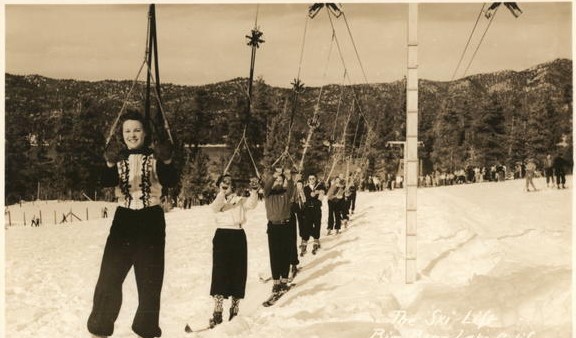
Today, Big Bear Lake is a vacation destination packed with modern marvels to check out in combination with stunning natural features that offer options for recreation and outdoor fun in abundance. However, travelers who head this way will also find that Big Bear Lake is a destination filled with rich history that’s worth digging into and exploring. While the establishment of the city itself dates back to the mid-19th century, the discovery of area gold also played a role in the area’s development over time. Today, some of the most impressive and iconic stops visitors make in Big Bear can be linked back to surprisingly simple irrigation solutions. Winter travelers can thank competitions established in the early 1920s for access to incredible slopes and ski options today. We have compiled some of the best information out there about the intriguing history that makes a visit to Big Bear Lake so fascinating!
For many years the only humans to see Big Bear Valley were the Indians. Several tribes lived around the San Bernardino Mountains, extending from Mexico along the west coast and into the California Great Basin, they are a branch of the Takic speaking people who arrived in Southern California around 2,500 years ago. Most people were from desert tribes who spent their winters in present day Lucerne and Apple Valleys and their summers in Big Bear Valley. The natives hunted small animals like jackrabbits with traps, bows, and arrows, however in Big Bear Valley they were also granted pinon nuts. The Indians would grind down the nuts into a powder which they would mix with water and make into a paste that would be flattened like a tortilla and then cooked, this became their primary source of food. Today you can still find Serrano mortar rocks with holes in many of the boulders throughout Big Bear where these native peoples would grind their pinon nuts into flour.
High in the San Bernardino Mountains at Yuhaaviat, an area of pine trees near present day Big Bear Lake, Kü̱ktac our Creator laid dying. When Kü̱ktac died, the people began to mourn and their grief turned into pine trees, which enriched the land with vegetation and animals, allowing future generations to thrive. The people who lived at Yuhaaviat were known as the Yuhaaviatam, or “People of the Pines”, and were a clan of Maara’yam (Serrano) people. The location of this creation story is said to be “The Eye of God” near Baldwin Lake, a quartz dome and landmark in Big Bear. The Serranos worshiped the dome, which they referred to as the eye of their creator Kruktat (Kokitach), holding this as a sacred place and believe his spirit is still there. Originally a full dome it was dynamited in the 1940’s when it was falsely believed to be full of gold.
Their creation stories involve a God, Kruktat, who created the People. After falling ill, Kruktat journeyed to the mountains where he lay dying in a bear cave. Tended by the First People, he was taken to Maktsuk, today called Pan Hot Springs, where he was bathed by human caretakers. Knowing he was dying, Kruktat instructed the People to cremate him and protect his body from Coyote, who eats dead things. Kruktat died near present-day Baldwin Lake. During the cremation the eye of Kruktut flew out and became a giant snow quartz megalith known as Aapahunane’t, or God’s Eye. Coyote snuck through the bowed legs of bear and snatched Kruktat’s heart in his mouth. The people hit Coyote, and as he ran into the mountains above Baldwin Lake, the dripping blood turned the rocky soil red. When the creator died the people mourned and their tears turned into pine trees, the area called Yuhaaviat. The nuts from the trees became food for the Yuhaaviatam, or People of the Pines.
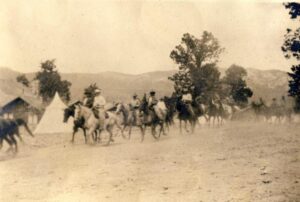
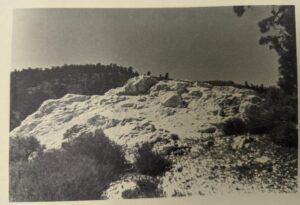
The first Spanish explorers of the area identified our ancestors as the “Serrano” people, the Spanish term for “highlander.” Many terms have been used in many languages to describe our people. The word Maara’yam, or the People of Maara’, is used to describe all peoples known today as Serrano. The name Yuhaaviatam, or People of the Pines, refers to the Serrano clan of our progenitor, Santos Manuel who originated in the San Bernardino Mountains in present day Big Bear.
An estancia in Redlands, modernly known as the Asistencia, was established in 1819. This outpost held many Maara’yam (Serrano) people as well as other indigenous people from nearby regions, using them as labor for mission support. One notable feat was the building of the Mill Creek Zanja, a massive irrigation system that extends from the base of the San Bernardino Mountains through Mentone, Redlands, and Loma Linda. This feature supported agriculture across the region and is listed on the National Register of Historic Places with the notation that it was built by Serrano men.
In addition to the Mission system and the agricultural industry, opportunities related to logging and the Gold Rush drastically changed California, bringing in new settlers who created ranches, farms, mines, and logging camps. Not only did these newcomers want to establish ownership over the land, but they also wanted to use it without obstruction. As a result, indigenous people who remained on their ancestral lands were viewed as a nuisance and were often the victim of harsh treatment and violence.
One such group of people was the Yuhaaviatam (“People of the Pines”) of Maara’yam (Serrano) people, who had remained in our homelands across the Big Bear Valley and spoke Uto-Aztecan, part of the Takic subset. In 1866, as anti-Native American sentiment ran high, a skirmish between a California state government-sanctioned Malita from the San Bernardino Valley and Maara’yam (Serrano) Indians triggered a month-long killing spree of the native peoples across the Big Bear area at a location known as Chimney Rock. Their Kiika’, (Tribal Leader) Santos Manuel, led the remaining Yuhaaviatam – numbering only 20-30 people total left- away from their mountainous homelands into the San Bernardino Valley. The massacre was a response to a raid that is speculated to have been carried out by Chemehuevi Southern Paiutes on a white settlement at Lake Arrowhead during which multiple buildings were burned.
The story of how other people came to the valley actually begins in the town of San Bernardino which was settled by Mormons in the early 1800s near the Spanish Mission. In the 1840’s the area around San Bernardino was rocked by numerous earthquakes, causing the local tribes to become very nervous under the fear that the earthquakes were the Great Spirit angry that they were allowing the white man to settle there. As a result, the Indians began to raid the ranches around the tiny town of San Bernardino, stealing the rancher’s cattle and burning down their crops and barns.
In 1845, the citizens of San Bernardino became very angry with the Indians who had been raiding at night and escaping back into the mountains before the sun came up. They were stealing numerous horses from local ranchers. The Indians drove the horses, numbering in the thousands, up to the high desert near Lucerne Valley. One of the ranchers, Benjamin David Wilson (also called Don Benito Wilson by the Spanish), offered to take a posse of men into the mountains to catch the Indians. Benjamin Wilson and his men went on horseback over what is now Cajon Pass. They chased the Indians over the pass and through what is now Lucerne Valley. The Indians headed over the mountains from the desert side. Benjamin Wilson and his men followed. What they found was a valley covered with many pine trees and a swamp at the east end. A stream ran down the center of the valley. They never caught the Indians, but they did find many bears living in the valley. The men roped and teased the bears. Soon they returned to San Bernardino and Benjamin David Wilson named the valley he had discovered Big Bear Valley. At that time there was no Big Bear Lake as there is today. Wilson did name the swampy area he found at the east end of the valley Bear Lake. (This is what we now call Baldwin Lake.) Benjamin David Wilson who discovered Big Bear Valley, later became the mayor of Los Angeles. Mount Wilson is named after him.


By the mid nineteenth century, the San Bernardino Mountains and Valley were becoming enveloped with civilization. Travelers, merchants, families, and explorers were constantly trekking the area, using the old Indian trails and logging roads that had started to become the highways and boulevards we know today. As travel increased, so did the need for supply stations, stores, and purveyors of daily provisions. Pioneers heading into and out of the San Bernardino mountains frequently used an access road originally designated to transport timber to construction sites in the San Bernardino Valley however over time the trail eventually became Highway 38.
American prospector William (“Bill”) Holcomb had tried his luck at the gold fields up north and was now heading south, hearing that there might be gold in Big Bear Valley, but he was not sure how to get there. After asking around in San Bernardino, he finally found someone who knew where the valley was. Holcomb and his companion Jack Martin followed the directions and set out to find Bear Valley, forcing their horses through extremely deep snow to reach Big Bear, arriving in the valley in 1859. There he met up with some other miners who had been trying their luck at what they named “Starvation Flat” or “Poverty Flat.” These were good names for this area since hard working miners only brought in about $5.00 a day. The area they mined and settled is just south of what is today, Stanfield Cutoff, just above Big Bear Boulevard, near the Stater Brother’s Shopping Center. Both Holcomb and his partner Martin were sad that they had not found much gold, causing Jack Martin to return to his family in Los Angeles. Bill decided to stay.
Like the others, Holcomb suffered from a lack of supplies and minimal gold finds in the rural mountain community which led him to start tracking and hunting local grizzly bears in the area for their meat, hence his nickname “Grizzly Bill” Holcomb as he kept the minors fed and is said to have killed off every last bear in the area. Bill Holcomb shot a bear, wounding it. Bill and another miner, Ben Chouteau, decided to follow the wounded bear. They tracked the bear into a beautiful little valley just north of Big Bear Valley. When Holcomb returned to the camp to tell his friends of the new discovery, people began to call it Holcomb Valley. Later, Bill and Ben decided to go back into the valley in hopes of finding more bear. While they were there, they tried a little gold panning. Much to their excitement and surprise, they found gold.
On May 5, 1860, Holcomb and Ben Ware arrived at the office of the County Recorder to record five gold claims located in Holcomb Valley, five miles north of Bear Valley. The men returned the next day to the valley to stake their claims. This was just ten days after Bill Holcomb had left the state of Indiana to come to California to seek his fortune. About a month later that Spring the minors all chipped in and sent Martin to San Bernardino for flour. The people down below knew that Bear Valley was producing very little gold so when Martin paid for the flour with gold dust, the men in San Bernardino followed him back and found out about Holcomb Valley. They rushed to mine its rich sand and shale placers, and that was the start of the Holcomb Valley Gold Rush, soon hundreds of men and women had arrived in Holcomb Valley to mine.
Soon Holcomb Valley was filled with many shacks and buildings. Most of the buildings were put up very quickly and were not well built. To celebrate the Fourth of July, the wife of one of the miners, Mrs. Jed Van Duesen sewed an American flag. Legend said it was made of cloth from miner’s shirts and the skirts of dance hall girls. Soon after, the miners raised $1,500 to build a wagon road from Holcomb Valley to Cajon Pass. Mr. Jed Van Duesen was asked to build the road. Once the road was finished, machinery and lumber were able to be brought into the valley much more easily. Today you can travel a portion of this wagon road when you go down Van Duesen Canyon Road in Big Bear City. The miners got together and decided to name the town that was now in Holcomb Valley. In honor of Mr. and Mrs. Van Deusen’s daughter Belle, they named the town Belleville. More and more miners arrived in Belleville. Very soon it became a lawless town with gunfights, fist fights, and murders. Something had to be done to bring law and order to the town. A constable was elected. A constable is like a sheriff. The people of Belleville who wanted law and order finally won out over the gangs of miners who wanted to steal and kill. Many bad men lost their lives on the Hanging Tree which is still standing today. The gold rush in Holcomb Valley lasted about 10 years, from 1860-1870. One by one the people of Belleville began to move away from the area. The gold was becoming harder and harder to find.
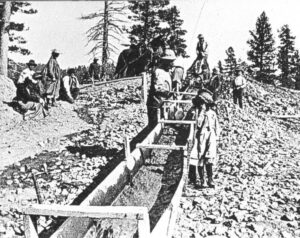
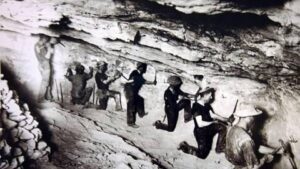
In 1873 gold was discovered at the east end of Holcomb Valley. Elias J. “Lucky” Baldwin found out about it and built a large stamp mill at the edge of a cliff on Gold Mountain. The stamp mill used heavy machinery to stamp the rock and crush it. Water was then washed over the crushed rock. Since gold is heavy it was left behind after the rock was washed away. The crashing noise of the stamp mill could be heard throughout the valley as tons of rock were crushed in hopes of finding gold. The Gold Mountain Stamp Mill ran for about 20 years. The gold again became harder and harder to find. Soon it was felt that it cost more to get the gold than it was actually worth. Because of the discovery of gold in Holcomb Valley, more people came, and many improvements were made. A road was carved through the mountains to the bottom of the hill. Electricity was brought over the mountains from Victorville (then called Victor). Telegraph and telephone wires were strung up. Most important, the first communities were built. The town of Doble grew up at the foot of Gold Mountain during the years when Baldwin Stamp Mine was running. By 1915 most of the people had moved away from Doble.

The earliest cattle ranching in our valley was 1879 by “Gus” Knight who entered the mountains in 1866 as a lumberman, built a hotel in Bardstown in 1875, then settled into the cattle business.
Located in the upper Santa Ana River basin was a camp ran by the infamous McHaney Gang, a group of men with an unsavory reputation for shenanigans and cattle stealing. Of the two brothers John W McHaney was the more ruthless law breaker, collecting four reckless individuals like himself, and they became known as the McHaney Gang. The gang was made up of the leader Jim along with Willie Button, Ike Chestnut, George Myers, and Charles Martin. The summer hideout was the McHaney Ranch until increasing traffic on the Bear Valley Trail obliged them to move further up Santa Ana Canyon to “Big Meadows”. Well into the 1880’s the McHaney gang continued to rustle and rebrand cattle becoming so bold as to steal animals from nearby herds in Bear Valley, Highland, and Redlands areas. This proved to be their undoing as a posse of East San Bernardino Valley ranchers although failing to kill or capture any of the gang, did manage to chase them out of the mountains in 1887. Charles Martin put on an appearance of respectability in later life and was appointed the chief of police for San Bernardino in 1917. In his final years he subdivided his mountain property which became known as Glenn Martin with his son-in-law Cliff Shay.
Remember that Big Bear Lake as we know it today was not there when Benjamin Wilson and Bill Holcomb visited and lived in the valley. There was a stream that ran down the center of the valley. This stream joined up with other streams in the San Bernardino Mountains and became the Santa Ana River. The Santa Ana River was the most important source of water to all of Southern California at that time. Around 1880, the town of Redlands was being built. Water was needed for the many orchards and groves of trees. Frank E. Brown, an engineer, was asked to come to Big Bear Valley and see if it would be possible to build a dam at the west side of the valley. An engineer is someone who is trained to build structures like dams, bridges, and roads. A dam is a wall of rock or concrete designed to hold back water. Brown made measurements and decided that a dam could be built. The area behind the dam would be a lake. The people who owned this land were paid for it. Trees were cut down. The dam was built of granite rock found in the valley. The cement to hold the rock came from England. It had to be brought by ship to Los Angeles, by train to Colton, by mule over Cajon Pass and up the back grade to the place where the dam was being built.
In 1884, the Excelsior Water Company dug a 650-foot tunnel to supply water to Mentone, tapping into Greenspot Springs along Mill Creek northeast of the Greenspot Market in Mentone. The original building of this historical site was a blacksmith shop before it became the Rocky Comfort Store in 1910. Cornelius and Ruthanne Hodenfield purchased the land and business in 1921 and again renamed it Hod’s Place, installing new fuel pumps dispersing Gilmore gasoline and began delivering groceries and dry goods to local residents. In 1927, Louis Stowells added the exterior stonework that you can still see today. The Great Depression took hold of the Hodenfield family who were forced to sell the property in 1931 as they returned to their home state of Iowa. The store passed many hands over the years being named Greenspot Trading Post, Hasty’s Ranch Market, Greenspot Liquor, and The Greenspot Store. The current owners have had possession of The Greenspot Market since 1992 and have collectively made every effort possible to preserve the uniqueness of this local landmark and continues to provide World Famous Jerky and a last stop for travelers passing through the Gateway to Big Bear. The Dedication Plaque in front of the market contains this story and was dedicated October 9, 2016, in conjunction with the Jacinto Family by the Billy Holcomb Chapter 1069 of The Ancient and Honorable Order of E Clampus Vitus.
The first dam was constructed in 1884, with a a very difficult test being given that first winter; one heavy snowfall formed a lake five miles long and one mile wide. The dam held. At that time, people said that Big Bear Lake was the largest man-made lake ever created. Frank E. Brown was honored for his engineering skill.

In the beginning, the lake was considered private, and no one was even allowed to put a boat in the water. James A. Boyd was the first to begin regular stocking operations in the eastern San Bernardino Mountains. He was the road master of Riverside in 1884. On May 23, 1884, he ventured into Mill Creek Canyon to scout practical routes to haul supplies to the Bear Valley dam site. Before reaching Thurman’s, he crossed the stream nine times with still very high water. Sylvanus Thurman joined Boyd on the trip to Seven Oaks and Bear Valley. The flood destroyed the fishponds at Seven Oaks and the river was still 132 feet wide. He arrived at the dam to see 40,000 inches flowing from the dam narrows where the year previously only 500 inches had flowed.
James Boyd returned to Bear Valley in July 1884 to camp with his family along Baldwin Lake and bring cement and other supplies for dam construction. His route was the rough Cushenberry Grade from Lucerne Valley. Boyd came to California is 1867 and found his way to Riverside in 1872. He purchased two large wagons pulled by four-horse teams and went into the freight business. His freight service took him to the desert mines and hauling lumber from the mountains. Lucky Baldwin hired him to haul the heavy stamp-mill equipment to his holdings near Gold Mountain. Frank Brown hired him to haul cement, tools, food, derricks, and kitchen items to the dam site in both 1883 and 1884. These freight service contracts brought Boyd into contact with the mountains and his fishing addiction lured him back to the lake regularly. In 1887, Boyd returned with 4,000 Lake Tahoe trout packed in metal tubs splashing along the steep road. The water company undoubtedly paid Boyd for his stocking. The company also forbade fishing in the lake for two years to allow the fish to grow and propagate. Bear Valley reservoir nearly turned to become a private lake when Herbert H. Garstin wrote William Medland the Bear Valley Mutual Water Co. receiver warning the State Fish and Game and James H. Boyd that planting 100,000 fingerling trout would be construed as a “waiver of rights in the future.” The State informed the Bear Valley Co. that the company could not charge fisherman on the lake or shore. By 1916 a compromise was reached that allowed the Bear Valley Development Co. the right to charge for boats on the lake but no fee for fishing.
The abundance of fish brought unsavory fishing tactics to the mountain streams. Men floated small rafts on Slide Lake and Big Bear Lake that had long fuses attached to dynamite. The blast stunned the fish and were then netted and hauled to local markets and restaurants for consumption. County Supervisors ordered county sheriffs to arrest and fine the illegal fisherman. Fisherman rules included the fifty fish per day limit obtained only with hook and line. The creation of the San Bernardino National Forest Reserve February 25, 1893, did not address the poaching or fishing problem since no rangers were hired for protection.
Los Angeles County game wardens inspected Bear Creek and the Santa Ana River in 1903 and found evidence of dynamiting trout using a beer bottle and lime method. Filling a bottle with dry lime and then water with a cork would produce an explosion in a stream pool and kill all the fish. Mrs. Mai Henry, co-owner of the Bear Valley Hotel, was arrested in 1905 delivering 215 pickled trout to Victor according to the San Bernardino County Sun November 15, 1905.
“Uncle Will” Shay purchased land southeast of Big Bear Lake in 1906. Later he partnered with a Banning investor Omar Barker, and together they purchased additional lands adjacent to the “Lucky” Baldwin mine and planned to use the property for ranching. The Shay and Barker Ranch was formed, utilizing a “club” and CO brands as they ran their cattle near Baldwin Lake and what is now today Big Bear City. Stone also reveals the cattle scales were at the site of the present-day Big Bear Airport, not far from their location. Shay and Barker wintered their herds down below in lower areas of Old Woman Springs and Lucerne Valley. Over time the Shay Meadow location was known as the “beef-fattening field”.
High under the outline spurs of old grayback lies the saga of the 1,280 acres cattle ranch known as Heart Bar Ranch. Albert Riley Swarthout came from a pioneer San Bernardino County family. His grandfather Nathan Swarthout reached San Bernardino Valley with General Kearney’s army of the west in 1847. His father George Washington Swarthout settled near present day Wrightwood in the 1850’s and Al, being born in 1872 spent most of his life in and around the San Bernardino Mountains. He was a Forest Ranger at Converse Flat from 1899 to 1905, becoming a flume guard for Pacific Light and Power Company. He entered the cattle business in 1907 buying half interest in Heart Bar with Charlie Martin and also purchasing Old Woman Springs Ranch for winter pastures. “Swarty” was now a cowboy and remained such for the rest of his long life, building a sturdy log cabin that was long a landmark at Heart Bar. He rebuilt a barn and corrals and turned Heart Bar into a first-grade cattle ranch.
He greatly enjoyed herding his cattle through the mountain meadows and forests, branding his animals and organizing the fall roundup he took personal charge of the fall drive, escorting his unwilling herd up over Onyx Summit over to Round Valley, down Rattlesnake Canyon and into the high desert to Old Waman Springs for the winter. After 6 months in the desert Swarty could hardly wait to herd his animals with their newborn calf’s back to his beloved Heart Bar Ranch. Ownership of Heart Bar was in flux during the years of 1914-1921 when Charles Martin sold his half interest to a Dr E. Scott Blair of San Bernardino. In 1914 Swarthout and Blair did not get along in cattle ranching together, causing Swarty to sell his half interest to Bob Bryant in 1918. Bryant also did not get along with Blair and later bought him out in 1920. Tragically the doctor did not get to enjoy the property or his time as the sole owner of Heart Bar as his wife and son were struck and killed while driving across the railroad tracks in Hesperia in 1921. Swarthout bought back his half interest in the property from the Blair estate and the other half was purchased by J. Del Gentry, a San Bernardino businessman. For many years Swarty and Gentry got along beautifully, later building a large house and lodge to accommodate guests. It was not uncommon during the 1920’s to find sometimes over 100 guests at the Heart Bar Ranch for the weekend. Swarthout and Gentry decided to split in 1938 however neither was willing to sell to the other his half interest in the ranch and winter pasture, eventually going to court and Swarthout was awarded the Heart Bar property while Gentry was awarded the Old Woman Springs Ranch. Swarty continued to live at the property until his death at age 91 in the year 1963. By 1965 the historic Heart Bar Ranch became a California State Park and 11 years later passed into the hands of the federal government. Today the center of the old cattle ranch is a national forest campground.
[1911]
Illegal fishing tactics continued past 1905 even though Forest Rangers were designated fish and game wardens by the county. P. M. LeSage was acquitted for dynamiting fish in Bear Valley in 1911. Juries consisted of men that refused to convict anyone for fishing despite their tactics. Fred Herrmann and A. Worley caught 175 fish on Bear Creek below Slide Lake in 1911. A fishing limit of 50 per day was established by the County Board of Supervisors in 1912 and later amended to a limit of 10 pounds of rainbows per day.
[1912]
A dam-keeper was hired to watch over the old dam. The Bear Valley Mutual Water Company, which owned the dam, built a house for the dam-keeper on the rocks overlooking the dam. A telephone line was run from Redlands to the dam-keeper’s house. Soon after, the telephone line was run from the dam-keeper’s house to the village of Pine Knot. Pine Knot was the first name of what we know as the town of Big Bear Lake. A few years after the first dam was built, the growers in Redlands realized that in order to make sure they had enough water for their groves, a higher dam, holding back more water, was needed. This dam was to be made of concrete filled with rock. After it was finished, the lake level rose to 72 feet, 20 feet higher than the old dam. The new dam was completed in 1912.

[1915]
Soon after the dam was built, the community of Big Bear Valley and especially the town of Pine Knot became a resort. A resort is a community where people go for vacations. Usually people do not live there all year round, but go during one season for a short time. The leaders of Big Bear Valley wanted people to come to spend their vacations. They sponsored car races from communities in Southern California up to Big Bear. They advertised. Lodges and cabins were built. People began to come to Big Bear for their vacations, especially in the summer. Few people lived year round in the valley. The winters were very cold and most cabins were not built well enough to keep people warm.
One man who was very important to the valley at this time was Stanbridge A. Skinner, or “Dad” Skinner, as everyone called him. “Dad” Skinner wanted people in Los Angeles to hear about Big Bear Valley. He started the Chamber of Commerce for the valley in 1919. A chamber of commerce is a group of businesspeople who get together in hopes of bringing businesses and tourists to their area. “Dad” Skinner was a high school teacher in Redlands who spent his summer vacations in Big Bear and felt it was his real home. He put ads in newspapers in Los Angeles telling everyone about the beautiful valley. He organized trips for people from Los Angeles and San Bernardino to Big Bear on the Rim of the World Highway. He even did commercials on radio about Big Bear. Another way people heard about the valley was through motion pictures or movies. Many early silent films were made in Big Bear Valley. The valley was close to Hollywood and offered forest scenery and real snow. Some studios in Hollywood even built movie sets in the valley that they used over and over again. Today, at Cedar Lake Camp, the mill and several of the other buildings were actually movie sets at one time. Movies and television shows are still filmed in Big Bear.


[1923]
A road was built on top of the dam in 1923 so that cars could drive from one side of the lake to the other.
Between 1928 and 1955, thousands of head of cattle from three different ranches were raised, slaughtered, and sent off to market from China Garden in Big Bear Lake.
A group of famed ranch and cattle workers gathered together for a day full of BBQ and good times in Moonridge in 1937. Photos include attendance by Cliff Shay, Dale Gentry (half owner of Heart Bar Ranch and California Hotel in San Bernardino), Harry Allison (owner of Allison Ranch west of Running Springs and county clerk for over 40 years), Al Swarthout (half owner of Heart Bar Ranch), Jim Cram (Greenspot orange rancher), John and Will Talmadge (owners of IS Ranch), Will Shay (owner of Shay Ranch), and Emmett Shay, a San Bernardino County Sherriff at the time.
[1977]
Big Bear Municipal Water District acquired the dam and other assets from the Mutual Water Company in 1977.
[1996]
In 1996, the Metropolitan Water District, the entity that manages Big Bear Lake, entered into an agreement to preserve the lake water by providing irrigation from another source to the owners of Big Bear Lake’s water. Since then, lake levels have remained much more stable.
[1870] –
The first recorded account of skiing in Southern California was found in the diary of Joseph B Tyler, dated February 3, 1873.
[1920 – 1925]
The first years of visitors were made up primarily of spectators and competitors attending winter carnivals for Scandinavian ski jumping, the most popular form of the sport at that time, and often landing front page headlines in the Los Angeles newspapers. Gradually the future of skiing as a sport evolved into the downhill variety with many ski tows being reported. By the 1920’s our San Bernardino Mountains were gaining fame for their iconic snow and winter sports, with early settlements being noted in Lake Arrowhead, Blue Jay, Running Springs, Snow Valley, Green Valley Lake, and Big Bear Lake. In fact, the first recorded ski jumping meet was actually in Big Bear Valley held on February 24, 1924 at Moonridge Meadows which is todays Bear Mountain Resort.
Word was bustling that Lake Arrowhead Village was being developed by J.B. Van Nuys and managed by Paul Bauman, a Swiss engineer, which drew many ski enthusiasts, instructors, and competitors from all over the nation to flock to the area in search of work. Early pioneers Edi Juan and his wife Eli Juan were expert cross-country skiers and ski jumpers from Switzerland and established themselves in Lake Arrowhead in the early 1920’s, skiing more for necessity than sport at that time being the only locals that knew how to ski. They were often chosen to assist with winter repairs on downed telephone lines and carry mail on skis once a week from the main highway down to Lake Arrowhead, a 25-mile round trip trek, which he continued to do for two years in the winter months when necessary. The husband-and-wife duo were Winter Sports Carnival winners, Lake Arrowhead Ski Club racers, and accomplished ski mountaineers, scaling San Gorgonio Mountain on skis in a group with five other people in 1934.
Walter Mosauer, recruited by the North Shore Tavern of Lake Arrowhead, directed the first ski school and winter sports programs out of the Lake Arrowhead Village business. Although advertised as a North Shore Tavern program, Mosauer’s Ski School actually took place at Keller Peak near Snow Valley, where the elevation and terrain were much more favorable than the Village.
[1925]
By 1925 the quaint town of Green Valley Lake was being created by Los Angeles developers Dewitt and Blair who began building roads, subdividing lots, and completed the iconic dam which launched a widespread advertising campaign and the creation of the town clubhouse and “The Top-of-the-World Club”- open only to lot owners of the town. By 1929 the State Highway Department cleared Green Valley Lake Road in preparation of the expected crowds for a possible ice-skating area, toboggan hill, and ski jump location that were already in the plans for the area.
[1928]
Les Salm worked as Lake Arrowhead’s Fire Chief for 23 years, constructing many of the first tows in the area, and giving Snow Valley its name. In the late 1920’s the area was known as Fish Camp was developed into a roadside resort and lumber mill by the Swetkovich brothers, becoming extremely popular with skiers and was a favorite destination of the Lake Arrowhead crowd, therefore Salm started calling it “Snow Valley”.
[1930]
Later in the 1930’s the Lake Arrowhead Ski School was formed by Otto Steiner who continued to take advantage of the adverse terrain available at Kellers Peak however it was a trek to the top and one ski down at the time with no mechanical uphill transportation available yet. By the 1930’s the slopes at Fish Camp (Snow Valley) were developed for tobogganing and skiing by the Arrowhead Springs Cooperation. With the support of then manager Sverre Engen, the Forest Service formally changed the name at the end of 1937. His recount of a 1932 expedition concludes that the road ends at Fish Camp where John Swetkovich, nicknamed “Johnnie Sixbits”, operated a sawmill along with 6 cabins where he built a 1,000-foot-long rope tow utilizing Swetkovich’s steam-powered logging donkey engine for power. This 1932 date is significant because with the exception of Truckee’s 1910 toboggan tow that skiers adopted as a ski lift, Salm’s Fish Camp tow was California’s first rope tow.
[1932] – Land of The Ski
By the 1900’s California State Chamber of Commerce had already spent a tremendous amount marketing and making a name for itself as the “Sunshine State”. This led to a real challenge to educate residents and visitors that Southern California could accommodate winter sports. Once they realized the financial boom that followed what was then dubbed the “white gold” marketing efforts shifted snow sports publicity and now clear roads permanently changed the direction of So-Cal’s Ski Resorts. Businesses that would normally be shut down for the winter could now reap the benefits of the ski crowd, bringing many local jobs to local communities including restaurants, gas stations, and of course lodging. By 1932 the State Chamber claimed California would also be known to the world as “The Land of The Ski”.
[1938]
This all changed in 1938 when Edi Juan and John Elvrum, frequent visitors to the mountains, teamed up together to build the first sling lift mechanical tow, situated on a hill above the Village, where the Fire Station sits today. The tow was easily accessible to guests staying at the Village Inn and other local lodging, featuring a 1,200-foot tow with access to a wide variety of runs and sparked ski promotions and instructors in the mountains to residents and visitors.
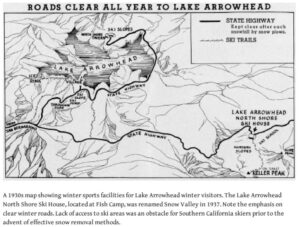
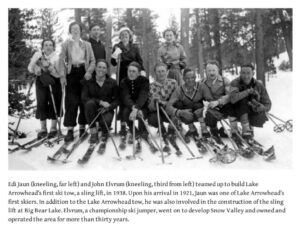
[1939] – World War II
Winter Carnivals and Ski Jumping Competitions dominated the 1930’s but came to a halting standstill with the breakout of World War II in the Fall of 1939 and snow sports were severely affected for the next 5 years until the war ended in 1945.
[1942]
Les Salm, a Michigan born pioneer made a number of contributions to Southern California’s early ski history. Serving as the San Bernardino National Forest Ranger from 1927-1942, he became intimately acquainted with the mountains through his motorcycle patrols from Lake Arrowhead to Snow Valley. The first fire chief of Lake Arrowhead County Fire District starting on July 20, 1942, he was extremely active in establishing post-war skiing in the mountains, immediately building a rope tow in Lake Arrowhead, dubbed Lodge Hill Ski Tow, one of the first sites that he conducted early experiments with snow making.
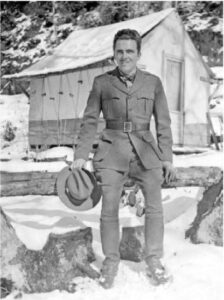
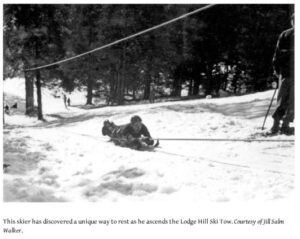
[1945-1946]
Once the war was over there was great interest in reviving the popularity of Southern California Winter Sports Centers back to what was known could be, as such many of the Tenth Mountain Division servicemen returned to their home turf to begin developing areas to teach skiing to civilians which they learned from the war. By the winter of 1945-1946 the town of Green Valley lake gained fame in the winter sports scene with the creation of “Snow Bowl” sitting at 7000-foot elevation making it the highest San Bernardino Mountain Ski Resort at that time. Over the next couple years, the area grew with extensive improvements including a warming hut, snack bar, rental room, ski school and rope tow, and a new building dedicated to the National Ski Patrol in 1948. 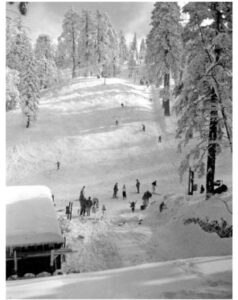
[1947-1948]
By the winter season of 1947-1948 Salm’s snowmaking was in full effect despite the marginal natural snowfall that year. While other snow making operations at that time relied on hoses and water, Salm’s approach utilized the cloud seeding method, likely inspired by the work that had taken place by General Electric in Schenectady, New York. In early November 1947, Salm consulted with Big Bear Lake’s Clifford Lynn and the Lake Arrowhead Chamber of Commerce about snow making, moving forward with his experiments and documenting his activities in his daybooks. Here are some of his entries from that very difficult 1947-1948 season:
November 14, 1947- Made preparations to precipitate snow or rain with dry ice and balloon. Temperatures did not drop low enough.
November 15, 1947- Cold North wind blew rain clouds away. Snowed at Big Bear and fog iced the trees. Clouds to warm here to send up dry ice balloons.
November 20, 1947- Received hydrogen and dry ice for snowmaking.
November 22, 1947- Snowed 1.5 inches between 4am and 8am from putting dry ice in the clouds at S.P.L.O. (Strawberry Peak Look Out). Sent six hydrogen balloons with dry ice into clouds and it snowed from 9am to 2pm.
December 3, 1947- At 2pm, I released 2 balloons with dry ice from Summit. Nothing happened. Cloud was too warm. About 4:20pm Rusty Wiles and I flew dry ice with a box kit into clouds from Strawberry Peak Lookout. In about 10 minutes it began to snow on the peak and rain fell at Blue Jay, Alpine, and Lake Arrowhead. After snowing for 20 minutes, the kit broke away and it stopped snowing almost immediately, but rain continued to fall at lower elevations.
January 25, 1948- Moist marine air swept into Southern California today… this is the first moisture in seven weeks of droughts. I tried to get dry ice to fly into the fog with box kit to start precipitation.
February 4, 1948- 9pm- Went to Crest Summit and attempted to fly dry ice into clouds but wind was too gusty to launch kite.
Salm’s snow making experiments were the first attempts to manufacture snow for skiing in Souther California and some of the earliest in the United States. In January 1947, the season before Salm began his snow making efforts, Walt and Wynne Harmon advertised “California’s new winter sports center” with the opening of a 2,000-foot sling lift and rope tow system in Lake Arrowhead. The pair spared no expense in their business venture outfitting the Village with the latest ski equipment and clothing, however the natural snowfall in that area was inadequate therefore the area was short lived.
[1949] – The Lynn Lift
After the completion of the Lynn Lift (a single chair) in 1949 our little town of Big Bear Lake was officially claimed by Ralph Rupert, president of the Big Bear Winter Club, as having the greatest amount of ski lifts and tows than any other area in the United States at 12 total. This whimsical 1949 Winter Sports Map shows the locations of numerous ski and rope tows that sprang up between Twin Peaks and Snow Valley including the towns of Blue Jay (Blue Jay Resort) and Running Springs (Ski Hill at Camp O’Ongo, Wintergarten, Ski the Rim). Over the years, enthusiasm for winter sports has always run high in Lake Arrowhead, however at a lower elevation of only 5,100 feet, skiers eventually knew they could count on better chances of snow at higher elevations like Snow Valley and many Big Bear Lake areas.
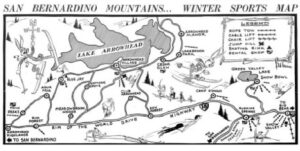
[1955] Moonridge Meadows
The first successful snow making operation at a ski resort in the United States was at Mohawk Mountain in Connecticut in the winter season of 1950-1951 however in 1955, Moonridge Meadows, now Big Bear’s Bear Mountain Ski Resort, was the first California ski area to successfully implement snow making operations.
By the mid 1950’s the ski boom had hit Southern California in a big way- for comparison in 1946 there was one chairlift in SoCal yet just 10 years later there were more than 14 ski areas, 13 chairlifts, and 64 rope tows within a 3-hour drive from Los Angeles. Today many of these areas dried or died out however those with the financial ability and good fortune of water available to install extensive snow making systems are still thriving today in the forms of Bear Mountain, Snow Summit, Snow Valley, and Mountain High. Those formerly popular Southern California ski areas from the 1950’s- Mount Waterman, Kratka Ridge, Ski Sunrise, Ski Green Valley, Snow Forest, Rebel Ridge, and others- only exist as memories and photos.
[1961-1962]
The final attempt at developing a successful ski enterprise in Lake Arrowhead was during the 1961-1962 season with the opening of the Lake Arrowhead Ski Bowl and the new double rope tow. In the event of no natural snow, it was reported that artificial snow “will be cut and spread a fresh 2 inches deep across the bowl each night after December 15 [1961]. By this time other lifts starting to spring up from slopes across the mountain region from Lake Arrowhead to Running Springs including the then popular destination town of Cedar Glen, where visitors had easy access to rental cabins, a grocery store, sleigh rides from the O.P. Doan stables, ski instructors, tow ropes, and sledding hills.
[1990] First Freestyle Park in North America at Bear Mountain Resort
By 1990 Bear Mountain had established its name with the opening of the very first freestyle terrain park in all of North America as well as the largest learning area, highest lift served peak (Geronimo at 8,805 feet), and the only halfpipes in Southern California.
Bear Mountain Resort History
Operated as Moonridge Meadows (1920 – 1943), Moonridge Ski Area (1943-1969), Goldmine Mountain (1970-1987), and Big Bear Mountain (1988-2001) the location was purchased by Snow Summit Resort in 2002 which consolidated both historic resorts under the umbrella of “Big Bear Mountain Resorts” with each of the three sites containing their unique brand. (Bear Mountain, Snow Summit, and Snow Valley)
